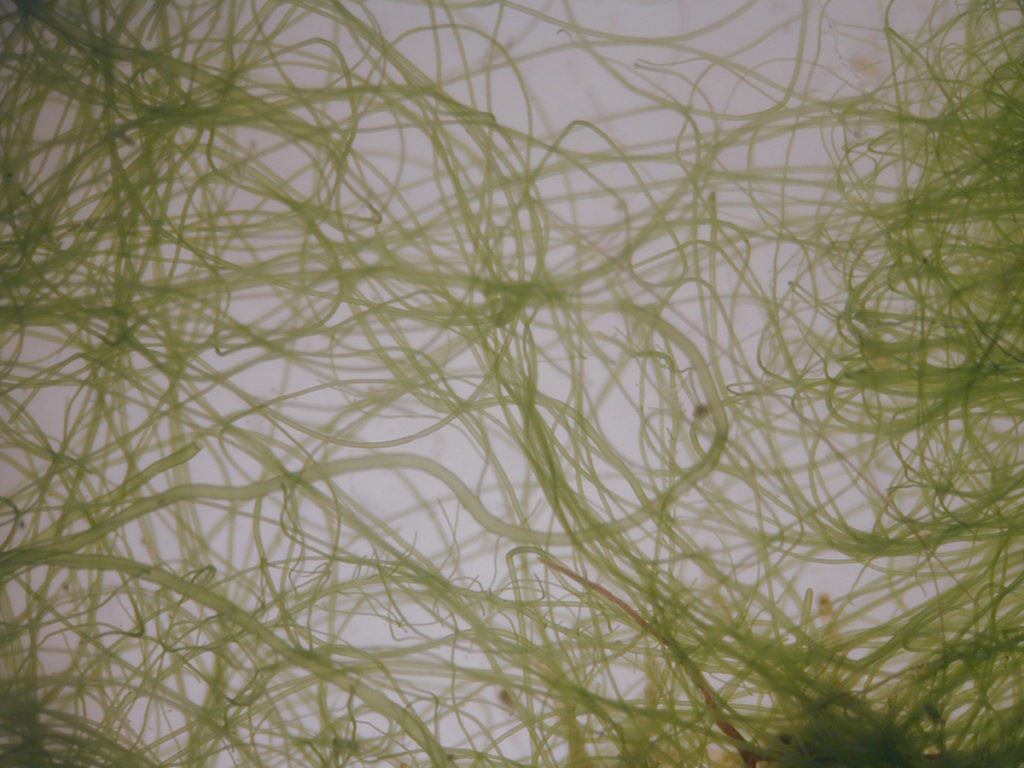
Leeward coast nuisance
The green seaweed Enteromorpha clathrata (Roth) Greville grows profusely along the shoreline on certain beaches on the west (leeward) coast of Guam between the low water line and mid-water line throughout the year.
The seaweed is considered an unsightly and odoriferous nuisance at Tumon Bay and East Agana Bay where growth along the shoreline is lush. Enteromorpha clathrata is classified within the Family Ulvaceae, Order Ulvales, Class Chlorophyceae and Division Chlorophyta. It appears filamentous-like. However, it is really a branched multi-cellular hollow cylinder which is only one-cell thick. The seaweed can reproduce by fragmentation, asexually via quadri-flagellated spores or sexually by the fusion of biflagellated gametes.
The growth rate of the seaweed is exceedingly high, up to two centimeters per day, and its abundance in any given site is influenced by nutrient enrichment along the shoreline, that is, by sewage, storm-water runoff and/or groundwater seepage. The amount of Enteromorpha at a certain site is dependent on the coarseness of the substratum which serves as anchors for the growing seaweed, wave height and action along the shoreline, and the feeding activities of herbivorous fish, especially the runs of juvenile rabbitfish during April and May.
Enteromorpha clathrata from Tumon Bay show a wide tolerance to salinity, temperature and nutrient levels. Studies conducted on Guam have shown that the optimum conditions for growth are at a light saturation of 2600 foot-candles or higher, temperature at 25ºC, salinity at 30 parts per thousand and nitrogen at 150 micro-gram atom per liter when the nitrogen:phosphorus ratio was maintained at 4:1. The dark green coloration in the seaweed is evidence of nutrient enrichment from groundwater seepage.
For further reading
FitzGerald, WJ. “Environmental Parameters Influencing the Growth of Enteromorpha clathrata (Roth) J. Ag. in the Intertidal Zone on Guam.” Botanica Marina 21, no. 4 (1978): 207-220.
Marsh, JA, Jr. “Terrestrial Inputs of Nitrogen and Phosphorus on Fringing Reefs on Guam.” Paper presented at the Third International Coral Reef Symposium, Rosenstiel School of Marine and Atmospheric Science, Miami, May 1977.
Matson, Ernest A. “Nutrient Chemistry of the Coastal Waters of Guam.” Micronesica 24, no. 1 (1991): 109-135.
–––. “Nutrient Flux through Soils and Aquifers to the Coastal Zone of Guam (Mariana Islands).” Limnology and Oceanography 38, no. 2 (1993): 361-71.
University of Guam Water and Environmental Research Institute of the Western Pacific. Urban Runoff in Guam: Major Retention Sites, Elemental Composition and Environmental Significance. By Gary RW Denton, Leroy F. Heitz, Rick H. Wood, Galt H. Siegrist Jr., Lucrina P. Concepcion, and Robert Lennox. Technical Report No. 84. Mangilao: WERI, 1998.
